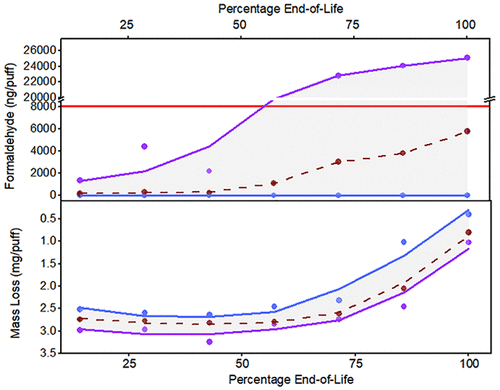当前位置:
X-MOL 学术
›
Chem. Res. Toxicol.
›
论文详情
Our official English website, www.x-mol.net, welcomes your
feedback! (Note: you will need to create a separate account there.)
Selected Harmful and Potentially Harmful Constituents Levels in Commercial e-Cigarettes.
Chemical Research in Toxicology ( IF 3.7 ) Pub Date : 2019-12-31 , DOI: 10.1021/acs.chemrestox.9b00470 Maxim Belushkin 1 , Donatien Tafin Djoko 1 , Marco Esposito 1 , Alexandra Korneliou 1 , Cyril Jeannet 1 , Massimo Lazzerini 1 , Guy Jaccard 1
Chemical Research in Toxicology ( IF 3.7 ) Pub Date : 2019-12-31 , DOI: 10.1021/acs.chemrestox.9b00470 Maxim Belushkin 1 , Donatien Tafin Djoko 1 , Marco Esposito 1 , Alexandra Korneliou 1 , Cyril Jeannet 1 , Massimo Lazzerini 1 , Guy Jaccard 1
Affiliation

|
A broad range of commercially available electronic cigarette (e-cigarette) systems were tested for levels of emissions of harmful and potentially harmful constituents (HPHC), with a particular focus on the carbonyls: acetaldehyde, acrolein, and formaldehyde. The tobacco-specific nitrosamines N'-nitrosonornicotine and 4-(methylnitrosamino)-1-(3-bipyridyl)-1-butanone; the elements arsenic, cadmium, chromium, lead, and nickel; benzene; 1,3-butadiene; and benzo(a)pyrene were also quantified. The results show that except for the levels of carbonyls, all types of e-cigarettes performed in a similar manner, and emission levels for HPHCs were generally not quantifiable. However, levels of carbonyls, especially formaldehyde, were highly variable. Overall, the lowest levels of formaldehyde were observed in cartridge systems, which generally achieved substantial reductions in yields in comparison with cigarette smoke. Formaldehyde levels in open tank systems were variable; however, the median formaldehyde levels across different brands were substantially lower than the formaldehyde levels in cigarette smoke. The results for variable-power devices operated at the highest voltage confirmed existing literature data regardless of orientation and differences in puffing regimes. Furthermore, our results show that many products deliver consistent HPHC yields over a broad range of testing conditions (with minimal variability from one device to another, under a range of puffing conditions). However, some products exhibit high variability in emissions of HPHCs. The use of air blanks is further highlighted to assess nonproduct-related contributions to HPHC levels to avoid misrepresentation of the data. Overall, our results highlight that some but not all electronic cigarettes deliver low levels of carbonyls consistently across the full e-liquid depletion cycle under different test conditions. The need for further research and standardization work on assessment of variable-voltage electronic cigarettes is emphasized.
中文翻译:

商业电子烟中选定的有害和潜在有害成分水平。
测试了范围广泛的市售电子烟(电子烟)系统中有害和潜在有害成分(HPHC)的排放水平,尤其侧重于羰基化合物:乙醛,丙烯醛和甲醛。烟草特有的亚硝胺N'-亚硝基壬二酸烟碱和4-(甲基亚硝胺基)-1-(3-联吡啶基)-1-丁酮; 砷,镉,铬,铅和镍的元素;苯; 1,3-丁二烯; 还对苯并(a)py进行了定量。结果表明,除了羰基含量外,所有类型的电子烟都以类似的方式运行,HPHCs的排放量通常无法量化。但是,羰基,尤其是甲醛的含量变化很大。总体而言,墨盒系统中的甲醛含量最低,与香烟烟雾相比,这通常会大大降低产量。开放式储罐系统中的甲醛含量是可变的。但是,不同品牌的甲醛中位数水平大大低于卷烟烟雾中的甲醛水平。在最高电压下运行的可变功率设备的结果证实了现有文献数据,而与定向和抽吸方式的差异无关。此外,我们的结果表明,许多产品在广泛的测试条件下(在多种抽吸条件下,一台设备到另一台设备的变化最小)可提供一致的HPHC产量。但是,某些产品在HPHCs排放方面表现出很大的可变性。进一步强调了使用空白,以评估与产品无关的对HPHC水平的贡献,以避免数据的错误陈述。总体而言,我们的结果表明,在不同的测试条件下,在整个电子液体消耗循环中,部分但不是全部电子香烟始终提供低含量的羰基化合物。强调需要对可变电压电子烟的评估进行进一步的研究和标准化工作。
更新日期:2019-12-31
中文翻译:

商业电子烟中选定的有害和潜在有害成分水平。
测试了范围广泛的市售电子烟(电子烟)系统中有害和潜在有害成分(HPHC)的排放水平,尤其侧重于羰基化合物:乙醛,丙烯醛和甲醛。烟草特有的亚硝胺N'-亚硝基壬二酸烟碱和4-(甲基亚硝胺基)-1-(3-联吡啶基)-1-丁酮; 砷,镉,铬,铅和镍的元素;苯; 1,3-丁二烯; 还对苯并(a)py进行了定量。结果表明,除了羰基含量外,所有类型的电子烟都以类似的方式运行,HPHCs的排放量通常无法量化。但是,羰基,尤其是甲醛的含量变化很大。总体而言,墨盒系统中的甲醛含量最低,与香烟烟雾相比,这通常会大大降低产量。开放式储罐系统中的甲醛含量是可变的。但是,不同品牌的甲醛中位数水平大大低于卷烟烟雾中的甲醛水平。在最高电压下运行的可变功率设备的结果证实了现有文献数据,而与定向和抽吸方式的差异无关。此外,我们的结果表明,许多产品在广泛的测试条件下(在多种抽吸条件下,一台设备到另一台设备的变化最小)可提供一致的HPHC产量。但是,某些产品在HPHCs排放方面表现出很大的可变性。进一步强调了使用空白,以评估与产品无关的对HPHC水平的贡献,以避免数据的错误陈述。总体而言,我们的结果表明,在不同的测试条件下,在整个电子液体消耗循环中,部分但不是全部电子香烟始终提供低含量的羰基化合物。强调需要对可变电压电子烟的评估进行进一步的研究和标准化工作。











































 京公网安备 11010802027423号
京公网安备 11010802027423号